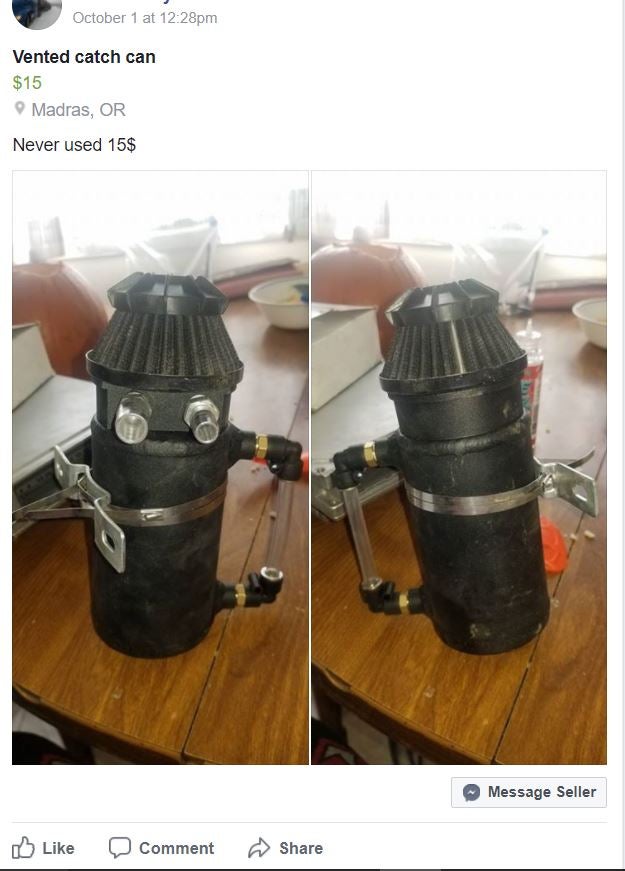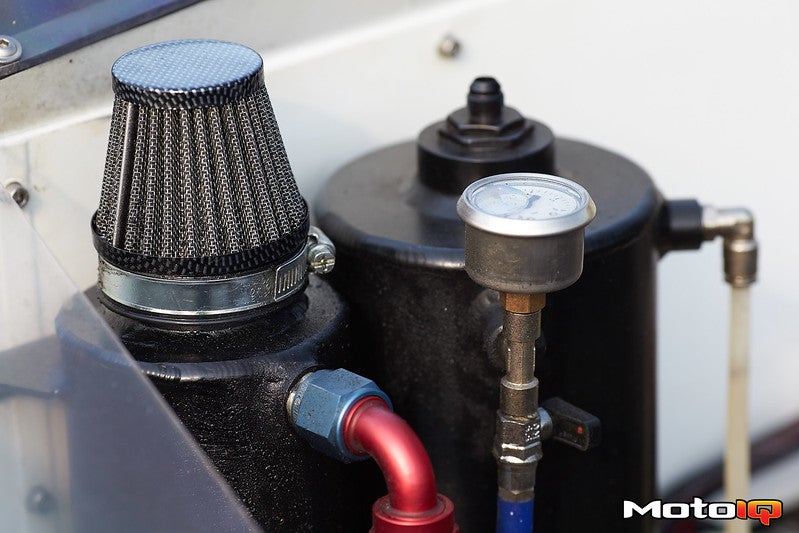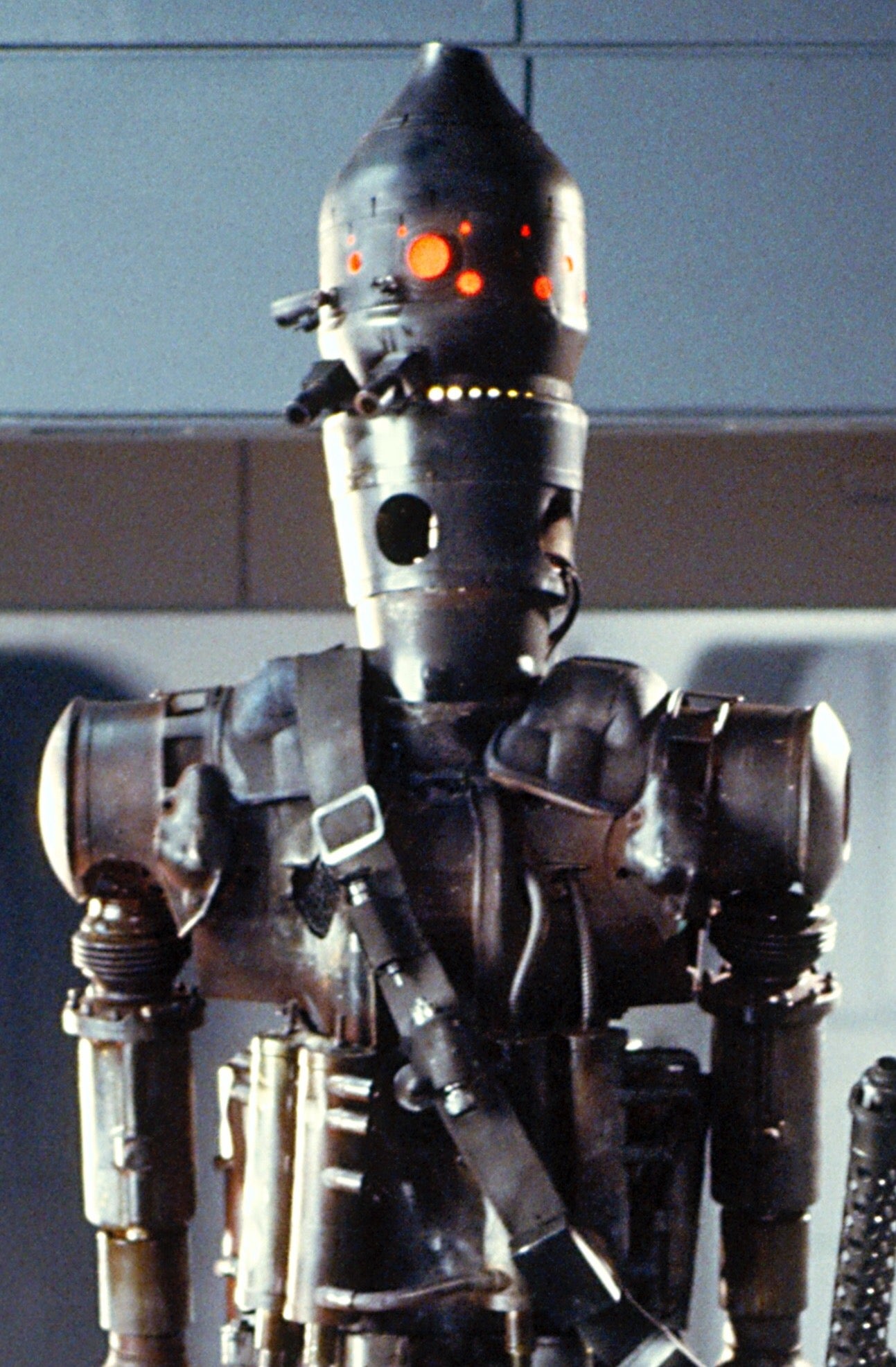 by "Tristan" (casselts)
by "Tristan" (casselts)
Published 10/05/2017 at 03:12
 by "Tristan" (casselts)
by "Tristan" (casselts)
Published 10/05/2017 at 03:12
No Tags
STARS: 0

Vented catch can... sounds about as useful as cross-drilled brake lines.
 "I have another burner, try to guess it!" (ihaveanotherburner)
"I have another burner, try to guess it!" (ihaveanotherburner)
10/05/2017 at 03:49, STARS: 1
IIRC these are used for converting power steering racks to manual. Because the rack still needs fluid, but you need a vent to keep pressure from building up.
Or something like that I think.
 "Echo51" (echo2047)
"Echo51" (echo2047)
10/05/2017 at 05:49, STARS: 0
I donít think you understand the actual function of a catch can, because it needs to be vented to somewhere. Stock cars vent into the airfilter normally.

^actual drift car setup for oil catch. See more at: http://www.motoiq.com/MagazineArticles/ID/4629/PageID/12229/Pinnacle-of-CharmóJames-Deanes-Worthouse-Drift-Falken-Tire-Nissan-S15.aspx
 "gogmorgo - rowing gears in a Grand Cherokee" (gogmorgo)
"gogmorgo - rowing gears in a Grand Cherokee" (gogmorgo)
10/05/2017 at 06:15, STARS: 0
Catch can needs to be vented.
As the engine warms up the air pressure increases in the crankcase and blows out somewhere, in addition to the tiny amount of combustion gasses that slip past the rings. Hence a crank-case vent. If you didnít have one youíd be constantly blowing seals. Most modern cars vent through the intake to draw a vaccuum on the crankcase, which helps to evacuate combustion gasses and other possible oil contaminants, and potentially increases efficiency given thereís less resistance to piston travel with less air displaced.
In the case of a catch can, thereís no vaccuum, and expanding gasses are pushed out the tube. Without venting the can thereíd be no crankcase venting, so no oil would be accumulating in the can, effectively defeating its own purpose. And youíd blow seals on the motor.
 "merged-5876237249235911857-hrw8uc" (merged-5876237249235911857-hrw8uc)
"merged-5876237249235911857-hrw8uc" (merged-5876237249235911857-hrw8uc)
10/05/2017 at 07:29, STARS: 2
I thought the catch cans just route in line, in between the vacuum side of the valve cover and the intake, so yeah, no venting required. The idea is the oily air gets pulled through the can and the oil condenses and is held in the catch can, meanwhile, the intake is still pulling a vacuum on the crankcase like it should. So if you vented it, then you would in essence short circuit the vacuum for the crank case. But like others have said, this type can could be used for a power steering delete to keep pressure from building in the PS rack.
 "merged-5876237249235911857-hrw8uc" (merged-5876237249235911857-hrw8uc)
"merged-5876237249235911857-hrw8uc" (merged-5876237249235911857-hrw8uc)
10/05/2017 at 07:32, STARS: 0
I donít think so, see my other response, no vent needed, the van runs in line on the vacuum side and still pulls a vacuum out of the valve cover, unless itís vented, then it wonít pull a vacuum from the valve cover, as it will pull through the vent instead.
 "merged-5876237249235911857-hrw8uc" (merged-5876237249235911857-hrw8uc)
"merged-5876237249235911857-hrw8uc" (merged-5876237249235911857-hrw8uc)
10/05/2017 at 07:35, STARS: 2
Dry sump oil overflow, not a catch can.
between runs. Beside it is the dry sump oil systemís breather and overflow tank. Together, they keep temps and lubrication in check for the critical engine parts under stress.
 "Aaron M - MasoFiST" (amarks563)
"Aaron M - MasoFiST" (amarks563)
10/05/2017 at 08:51, STARS: 1
Yup. There are two reasons catch cans route in line: first, rerouting your PCV is technically defeating an emissions device, and is illegal. Second, any open vent from within your engine will mess up your MAF sensor, which only works correctly if all air enters the engine through the MAF and exits through the O2 sensor.
If you arenít keeping the circuit closed (you donít care about VOC emissions and youíre using a speed density system or carb), you just take that little breather filter and put it directly on the PCV valve. No can required.
 "CalzoneGolem" (calzonegolem)
"CalzoneGolem" (calzonegolem)
10/05/2017 at 08:56, STARS: 0
Kinda looks like IG-88

 "merged-5876237249235911857-hrw8uc" (merged-5876237249235911857-hrw8uc)
"merged-5876237249235911857-hrw8uc" (merged-5876237249235911857-hrw8uc)
10/05/2017 at 09:37, STARS: 0
If you route a catch can in line and itís sealed, is it still considered defeating an emissions device? Modifying yes, but not defeating. My S8 has an oil separator with a bunch of little cyclones in it that does similar to a catch can and it routes the liquid oil back to the engine, itís pretty cool, and Iím surprised GM doesnít do similar on their systems.
 "Aaron M - MasoFiST" (amarks563)
"Aaron M - MasoFiST" (amarks563)
10/05/2017 at 10:00, STARS: 1
Sealed is fine (I realize I wasnít clear, I didnít think of a catch can as rerouting your PCV, merely sticking something in the line), itís just when you vent PCV to atmosphere that itís a problem...that said, certain places look specifically for cut PCV lines, so Iíd be careful about doing it in a place with visual inspections (i.e California) unless you enjoy explaining things to your mechanic over and over again. My 128i also had a built-in air-oil separator like the one you describe in your S8...I think most of the BMWs do. When I had my Subaru, I recall that Grimmspeed sold an AOS that replaced your oil cap and was supposed to serve a similar function, have a lot of maze-like spirals on which the oil could collect and drip back into the crankcase, instead of into a separate catch can.
 "Echo51" (echo2047)
"Echo51" (echo2047)
10/05/2017 at 11:32, STARS: 0
Breather and overflow. Just search around their site for catchcan.
 "gogmorgo - rowing gears in a Grand Cherokee" (gogmorgo)
"gogmorgo - rowing gears in a Grand Cherokee" (gogmorgo)
10/05/2017 at 12:21, STARS: 1
This is only if you hook it up to vaccuum. If itís not hooked to vaccuum then it needs vents. Most catch cans Iíve encountered are pretty well just a bottle with a hose running into the lid. If the hole the hose goes through is too tight you get zero venting and then oil starts weeping out of valve cover and oil pan gaskets, unless thereís some other form of venting included.
This comes from FSAE experience, where vacuum venting screws with your intake/restrictor setup. 600cc breathing through a beer-bottle neck means you want as little fuckery in there as possible. Youíve also got to put it upstream of the restrictor so youíre not pulling air around the restrictor, which further complicates things because now itís got to go in the nasty space between the restrictor and throttle body.
My team liked to run a red bull can with a hose into the top for our catch can during testing. For competition we switched to something a little more legit but itís the same idea, hose coming off valve cover and straight into catch can, and the line stops there.
 "Tristan" (casselts)
"Tristan" (casselts)
10/05/2017 at 14:40, STARS: 0
As I understand it... Normally, cars vent into the intake manifold via the positive crankcase ventilation system (PCV) Crankcase pressure is released, and oil vapors that would otherwise contribute to environmental pollution are drawn in by manifold vacuum and introduced to the combustion cycle. A problem arises from this otherwise great concept: buildup of deposits in both the intake manifold, and on the intake valves. This phenomenon is especially prevalent on modern direct injected engines, which lack the benefit of the fuel injectors spraying at the back side of the intake valve, removing the majority of these deposits. The catch can is a simple device with an inlet (from the crank case vent) and an outlet (manifold vacuum). Its purpose is to separate the incoming oil/air mixture, leaving the oil in a reservoir (the bottom of the catch can) and allowing the crankcase gasses (air and other pollutants that have bypassed the piston rings) to be drawn into the intake manifold and, subsequently the combustion chamber. For this to work, the catch can must be air tight. If a catch can is vented, such as the one that is the topic of this post, it wonít be a catch can... It will be an atmospheric crankcase vent with a bonus massive vacuum leak.
 "merged-5876237249235911857-hrw8uc" (merged-5876237249235911857-hrw8uc)
"merged-5876237249235911857-hrw8uc" (merged-5876237249235911857-hrw8uc)
10/05/2017 at 21:25, STARS: 1
I gotcha, youíre talking about a true catch can in lieu of a valve cover breather. That makes sense to vent that. What Iíve thought of as a catch can, and described, is in the pcv system. It goes between the line that is pulling vacuum via running into the air intake ahead of the throttle body. The supply side of the equation, or the breather like youíre talking about, would be supplying air from right after the air filter via a line running from the air cleaner box to the opposite valve cover. That way youíre getting filtered air pulled into the crank case and itís being pulled from through the pcv system or vent tubing, in GMs case. The catch cans Iím thinking of, would be in between the pcv and the inlet right before the throttle body. Thatís why youíd want a closed system for that purpose because the lines would be under vacuum.